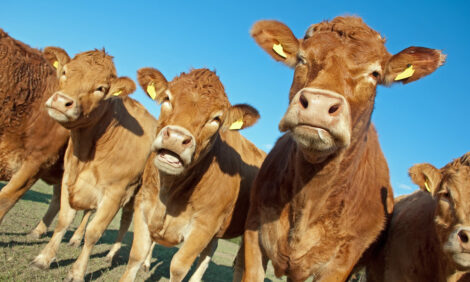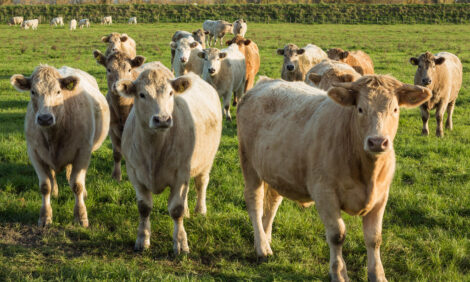



Feeding Round Bales Improves Efficiency
US - Winter feed represents the largest single cost on a cow-calf operation. Therefore when looking to reduce the cost-of-production, it is very important to take a long and hard look at winter feed costs.According to Prairie Post, science tells us that a 1,300 lb dry pregnant cow in good condition needs to eat about 27 lbs. of hay per day to maintain herself and grow a calf. But when beef producers project the feed inventory they need for the winter, they may actually estimate their cows feeding needs at 35-40 lbs. of hay per day. Where does the missing feed go? Producers are really tracking hay disappearance, rather than hay consumed by cows. Disappearance includes parts of bales spoiled during storage, dropped on the way to the feeder, and wasted or refused during the feeding process. Is there a way to improve this?
A beef producer can influence the feeding efficiency on their operation by helping to reduce the amount of feed the cows are wasting.
Cows are notorious wasters of feed, and there are some things a producer can do to minimise the amount of feed the cattle are wasting.
Research at the University of Missouri compared the efficiency of several hay feeding systems. The worst case scenario occurred with large round bales, fed-free choice without any feeder structure. In this situation the cows wasted 43 per cent of the hay offered. Unrolling large round bales in the field didn’t improve things much, if a week’s supply was placed at a time; losses remained in the 40 per cent range.
Things improved significantly with feeding on a daily basis, where the amount of hay offered was appropriately matched to the dietary requirements of the group. Unrolling just enough feed to last each day reduced losses down to 12 per cent. In this situation, cattle were actively competing for each mouthful and tended to cluster around the hay as it was being rolled out, so a relatively small amount was refused or spoiled.
Whether feeding on a daily or weekly schedule, using round bale feeders reduced waste. When offering a week’s worth of feed at a time, they cut waste by 80 per cent relative to no feeder, in the range of five or six per cent of the total feed supplied. Daily feeding using ring type feeders also had low wastage, in the five per cent range. If feeding daily, there must be enough feeders to allow each cow to eat at the same time. Feeding twice a week or once a week requires less time and labour, but you need enough round bale feeders to hold the required total amount of feed.
Prairie Post also looked at a study at Michigan State University, which compared feed wastage among different types of round bale feeders. Ring and ring/cone type feeders were the most efficient, resulting in an average of only 4.5 per cent waste, while trailer type feeders had 11.4 per cent waste. Cradle type feeders were the least efficient, with 14.6 per cent of the hay wasted. These results indicate that feeder choice is important.
In summary, no feeding system is perfect – the goal is to minimize feed wastage within a workable and cost-effective system. During the winter feeding period wastage can range from five per cent to 40 per cent, depending upon the type of feeding system.
Assuming that the price of hay is $90/ton, a five per cent waste would equal an extra seven cents/cow/day while a 40 per cent waste would equal an extra 54 cents/cow/day. Assuming a cattle herd of 100 cows and a feeding period of 150 days, feed waste for the winter would range from a low of $1,050 at five per cent waste to a high of $8,100 at 40 per cent waste. This is a difference of $7050, or 78 tons of feed. This example shows that by controlling waste, a livestock producer can reduce their cost of production.
TheCattleSite News Desk


